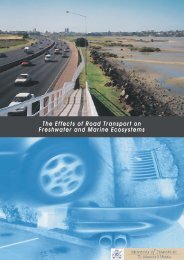National Freight Demands Study - Ministry of Transport
National Freight Demands Study - Ministry of Transport
National Freight Demands Study - Ministry of Transport
You also want an ePaper? Increase the reach of your titles
YUMPU automatically turns print PDFs into web optimized ePapers that Google loves.
<strong>National</strong> <strong>Freight</strong> <strong>Demands</strong> <strong>Study</strong><br />
2.5 Evolution <strong>of</strong> the freight sector and changes in the level <strong>of</strong> demand<br />
The surveys also sought to identify the way in which the freight sector is likely to evolve<br />
over the future in relation to changing patterns <strong>of</strong> demand and changes in the way in<br />
which freight might be handled and any constraints and issues which might impinge on<br />
this process. In developing future forecasts, these views <strong>of</strong> the respondents were<br />
combined with an appreciation <strong>of</strong> the data on recent trends and likely developments to<br />
produce estimates <strong>of</strong> future output and transport requirements for each <strong>of</strong> the major<br />
commodity groups identified. Forecasts for each <strong>of</strong> the commodities identified were<br />
produced for the short term (five years), medium term (10 years), and longer term (25<br />
years), and overall longer-term forecasts were produced for movements by rail and<br />
coastal shipping. These combined forecasts <strong>of</strong> the total growth <strong>of</strong> the sectors identified<br />
with an assessment <strong>of</strong> the way in which the rail or coastal shipping share might change<br />
over time, either in response to specific developments or to general changes in the<br />
modal position.<br />
The results <strong>of</strong> this forecasting exercise were then been compared with forecasts<br />
produced by other sources in particular the MoT 8 and <strong>Transport</strong> Engineering Research<br />
New Zealand (TERNZ) 9 .<br />
2.6 Other qualitative issues<br />
As indicated above, the interviews and surveys covered a number <strong>of</strong> other issues<br />
affecting the freight sector, including the ways in which the sector might develop in the<br />
future and the constraints that those involved in the movement <strong>of</strong> freight faced now or<br />
might face subsequently. We also used the information from the surveys and<br />
discussions to identify a number <strong>of</strong> the key issues affecting freight mode choice.<br />
A key part <strong>of</strong> our work was investigating the data that is available to assist those with<br />
interests in the sector, either by being involved directly or indirectly in the movement <strong>of</strong><br />
goods or in developing strategies and policies for the sector. In the course <strong>of</strong> the study.,<br />
it became clear that the level <strong>of</strong> information which was readily accessible on a regular<br />
basis was very limited. This is made clear in the <strong>Transport</strong> Monitoring Indicator<br />
Framework 10 recently published by MoT. In this framework, the information on the<br />
whole freight task is limited to aggregate estimates <strong>of</strong> the tonne-kms carried by road and<br />
includes nothing on any other modes or on any disaggregation <strong>of</strong> movements by road.<br />
While the current study provides a snapshot <strong>of</strong> the current position for all the major<br />
modes, this needs to be supplemented by regular and more detailed data collection to<br />
ensure that it provides a reliable foundation for on-going future action. We have<br />
therefore made recommendations about the level <strong>of</strong> information which might be<br />
regularly collected and disseminated in order to assist the development <strong>of</strong> an efficient<br />
freight sector.<br />
8 Unpublished research by MoT.<br />
9 Prediction <strong>of</strong> New Zealand‟s <strong>Freight</strong> Growth by 2020, TERNZ 2006.<br />
10 <strong>Transport</strong> Monitoring Indicator Framework 2008 Version 1, MoT.<br />
10
















